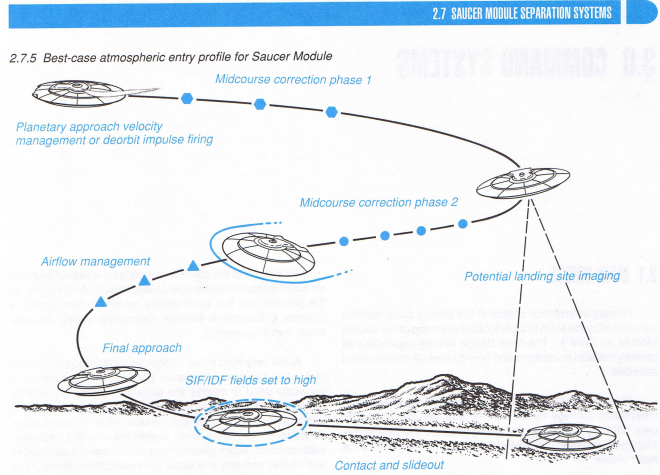No, neither the Constitution Class starship, nor the Galaxy Class starship are designed to land, except in extreme circumstances where a landing would be characterised as a catastrophic crash-landing.
Constitution Class Emergency procedures;
The best semi-canon "emergency landing procedures" for the Constitution-class Starship are detailed in "Mr Scott's Guide to the Enterprise".
Much of G Deck, in a wide area encircling the level. does not attain
full ceiling height. This is due to the underside concave structure of
the primary hull. This area houses cargo, the food synthesis system,
the saucer's life support, air conditioning, and battery systems, pump
machinery, port and starboard fresh water tanks, and the ship's
sanitary wastes recovery unit.
It is also this area in which the Enterprise's four massive emergency
landing legs are mounted. These units are stewed retracted, filling a
bay which carries up to F Deck. Extension of the landing legs allows
the primary hull to safely make planetfall following hull separation.
The implication is that the secondary hull parts (including main engineering, the warp engine and the stardrive elements and nacelles, etc) are explosively ejected. The ship then extends "Emergency Landing Legs" that will be used stabilise the primary hull (the saucer section) on landing. The saucer would either be abandoned, destroyed or taken back into space by another Federation vessel depending on the potential for violating the Prime Directive.
The semi-canon book, the USS Enterprise Officer's Manual (written by Geoffrey Mandel, senior Production Artist for various trek films and TV shows) offers this description of the emergency landing procedures for the Constitution-class saucer section:

Galaxy Class Emergency Procedures;
These can be found in the canon sourcebook; "The TNG Technical Manual";

Again, the secondary hull would be separated (in this case using the "Saucer Separation sequence") and the saucer would then use a mixture of shields and structural fields to prevent its occupants from suffering severe injuries on impact.
This sequence, originally planned for the TV series but shelved due to the extreme cost was ultimately seen in the film 'Generations';
Other sources;
In the non-canon Trek book "Rogue Saucer", the Enterprise is outfitted with new (experimental) saucer section that can supposedly survive a landing;
“I’m glad to hear you say that, Captain.” Admiral Nechayev leaned
across the table and stared at him with cold, hazel eyes. “You wanted
a chance to redeem yourself? Starfleet is not pleased by the fact that
emergency-landing a saucer section badly damages it in every scenario
we’ve tested. So we’ve built a prototype saucer section with improved
forcefields and dampening fields, in the hope that it can survive
atmospheric reentry, land, and be relaunched.
“The prototype has special thrusters that can lift it into the
atmosphere, where a tractor beam from an orbiting ship can pull it
into orbit. Theoretically, the hull section could resurrect its own
saucer section from the planet’s surface. If this proves successful,
we won’t risk leaving all that valuable technology behind for
indigenous people to dig up.”
Suffice to say, it's unsuccessful.


